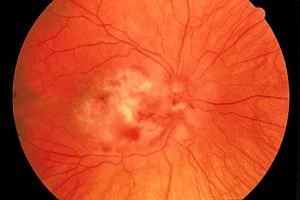Cytomegalovirus
It infects 90% of the adult population
Primary infection[edit | edit source]
Primary infection is usually mild or asymptomatic. It manifests itself as:
- infectious mononucleosis syndrome,
- febrile illness with lymphadenitis,
- hepatitis (especially in infants),
- severe congenital infections (microcephaly, blindness, hepatomegaly, purpura),
- congenital or postnatal infection - usually asymptomatic,
- rarely pneumonia, colitis, meningitis.
Reactivation in immunosuppressed manifests as:
- febrile illness with lymphadenitis,
- pneumonia,
- septic disease,
- colitis, oesophagitis,
- retinitis (especially in HIV positive),
- encephalitis.
Following a kidney transplant, a virus infection can cause transplant rejection.
Pathogenesis[edit | edit source]
The gateway is the respiratory tract or upper gastrointestinal tract. Then there is multiplication and subsequent hematogenous spread. It is associated with atherosclerosis and restenosis after heart surgery. The virus persists in salivary gland cells, renal tubules and leukocytes. The infected individual occasionally excretes viruses through saliva, urine, cervical secretion, and breast milk.
Diagnostics[edit | edit source]
Cultivation[edit | edit source]
Cultivation is easy. CMV grows with a typical cytopathic effect in 5-25 days on human diploid cells. Identification can be accelerated by evidence of nuclear inclusions with a mononuclear antibody (24-48 hours). We can use urine, saliva, vaginal secretion, breast milk (difficult), leukocytes (difficult) for cultivation.
Quick diagnostics[edit | edit source]
Antigen detection and microscopy are insensitive. Nucleic acid detection (PCR) is used. It is fast and reliable. Most sample types can be used. It is also possible to perform quantitative determinations. PCR is more sensitive than culture.
Evidence of antibodies[edit | edit source]
IgG, IgM or IgA are determined. IgG is anamnestic, for the diagnostics of reactivation they have a little importance, it is possible to determine the avidity of IgG. Both IgM and IgA are important in acute infections and reactivations. Non-specific reactions are described. Serology is only an orientation method. Antibodies do not indicate immunity.
Therapy[edit | edit source]
- Hyperimmune gamma globulin
- Antiviral treatment:
- ganciclovir;
- foscarnet;
- special new antivirals (cidofovir).
- Prophylaxis in high-risk patients;
- aciclovir (not suitable for the treatment of advanced infection).
Prevention[edit | edit source]
Vaccine attempts have so far failed. There are epidemiological measures in organ recipients (CMV negative recipients should not receive organs from a CMV positive donor) - due to the high population density, this is difficult to follow.
Links[edit | edit source]
Related articles[edit | edit source]
Literature[edit | edit source]
- HORÁČEK, Jiří. Základy lékařské mikrobiologie. 1. edition. Praha : Nakladatelství Karolinum, 2000. vol. 1. ISBN 80-246-0006-4.
- BEDNÁŘ, Marek – SOUČEK, Andrej – FRAŇKOVÁ, Věra, et al. Lékařská mikrobiologie : Bakteriologie, virologie, parazitologie. 1. edition. Praha : Marvil, 1996. 558 pp. ISBN 8023802976.
- ŽAMPACHOVÁ, Eva. Přednášky a materiály dr. Žampachové ke stažení [online]. [cit. 2012-04-20]. <http://mujweb.cz/?redirected=1521314685>.


